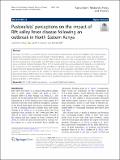Files in this item
Pastoralists' perceptions on the impact of Rift valley fever disease following an outbreak in North Eastern Kenya
Item metadata
| dc.contributor.author | Mburu, Caroline | |
| dc.contributor.author | Bukachi, Salome A. | |
| dc.contributor.author | Bett, Bernard | |
| dc.date.accessioned | 2022-07-11T09:30:08Z | |
| dc.date.available | 2022-07-11T09:30:08Z | |
| dc.date.issued | 2022-06-06 | |
| dc.identifier | 280400927 | |
| dc.identifier | b4bc4c76-268a-4a47-93ba-d00677844fcc | |
| dc.identifier | 85131451864 | |
| dc.identifier.citation | Mburu , C , Bukachi , S A & Bett , B 2022 , ' Pastoralists' perceptions on the impact of Rift valley fever disease following an outbreak in North Eastern Kenya ' , Pastoralism: Research, Policy and Practice , vol. 12 , 24 . https://doi.org/10.1186/s13570-022-00239-3 | en |
| dc.identifier.issn | 2041-7136 | |
| dc.identifier.other | ORCID: /0000-0002-8460-9213/work/115631005 | |
| dc.identifier.uri | https://hdl.handle.net/10023/25643 | |
| dc.description | This work was funded under the Dynamic Drivers of Disease in Africa Consortium (DDDAC), NERC project Number NE-J001570-1. This was funded with support from the Ecosystem Services for Poverty Alleviation (ESPA) programme. The ESPA programme was financed by the Department for International Development (DFID), the Economic and Social Research Council (ESRC) and the Natural Environment Research Council (NERC). | en |
| dc.description.abstract | Rift Valley fever (RVF) is a zoonotic disease which leads to livestock losses and human fatalities, thus impoverishing pastoralists who largely depend on livestock for their livelihood. These losses lead to both short- and long-term effects that perpetuate poverty and disrupt family order and structure. We used qualitative methods to understand the lived experiences of pastoralists with RVF after a major outbreak in Kenya. Using narratives, we identified the social, economic and psychological effects of this disease, while focus group discussions helped us to understand the experiences of the pastoralists during and after an outbreak. The major impacts were deprivation and impoverishment, abrupt disruption to their way of life and family dynamics and mistrust of the formal healthcare system. The latter was related to the isolation of patients and the presence of foreign medical personnel in the area that fueled mistrust. Efforts need to be made by public health practitioners and policy-makers to enhance dialogue between clinicians and pastoralists and to come up with practical ways of improving local people’s livelihoods during and after an RVF epidemic. | |
| dc.format.extent | 8 | |
| dc.format.extent | 1045057 | |
| dc.language.iso | eng | |
| dc.relation.ispartof | Pastoralism: Research, Policy and Practice | en |
| dc.subject | RVF | en |
| dc.subject | Public healthcare services | en |
| dc.subject | Livelihoods | en |
| dc.subject | Traditional medicine | en |
| dc.subject | RA Public aspects of medicine | en |
| dc.subject | NDAS | en |
| dc.subject | SDG 3 - Good Health and Well-being | en |
| dc.subject.lcc | RA | en |
| dc.title | Pastoralists' perceptions on the impact of Rift valley fever disease following an outbreak in North Eastern Kenya | en |
| dc.type | Journal article | en |
| dc.contributor.institution | University of St Andrews. Social Anthropology | en |
| dc.identifier.doi | 10.1186/s13570-022-00239-3 | |
| dc.description.status | Peer reviewed | en |
This item appears in the following Collection(s)
Items in the St Andrews Research Repository are protected by copyright, with all rights reserved, unless otherwise indicated.

